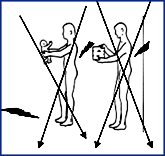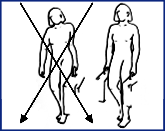| |
|
| THE
BEST WORK POSITIONS TO USE IN THE HOME |
| |
 |
Standing: |
| |
Try
to straighten your body, stretch your neck (not
the head), pull your shoulders back and your
stomach in. |
| |
|
 |
To go up a staircase: |
| |
AVOID: leaning
your weight on your hips; bending your
trunk forward, "climbing" up
the stairs with your pelvis.
TRY: stretch your body up keeping your
trunk straight and "climb" switching
the weight of your body, step by step,
from one foot to the other. You
|
 |
can hold the handrail
if necessary, but avoid forcing your arms.
(as it could cause shoulder pain).
Breath in through your nostrils every two stairs; breath out through your mouth
every two stairs. |
|
| |
|
 |
To descend a staircase: |
| |
TRY:
using the same method; stand on one foot
in each stair, shifting to your other foot as
you reach the next stair.
Breath in through your nostrils every 2 stairs
and breath out through the mouth every 2 stairs.
|
| |
|
 |
| |
 |
| |
|
 |
In the grocery store
(to lift an item): |
| |
 |
From a
high shelf:
Straighten your body and stretch your arm
without leaning forward. |
 |
| |
|
 |
In a lower
shelf:
Bend down your knees keeping your trunk
straight and your arm well stretched. |
|
| |
|
 |
Making your bed: |
| |
 |
To spread
bed sheets and blankets
Standing up, make several folds in the
sheet or blanket, holding it with both
hands. Move to one side of the bed, keeping
your trunk straight (avoid bending) and
your legs spread. Throw the sheet or blanket
over the bed without effort. Then, to extend
the sheets or blanket, go to the other
side of the bed; kneel down with your trunk
straight; turn your body to the left -without
bending your back- and then turn to the
right and do the same. |

|
 |
To
get the sheets or blanket under the mattress:
Stay kneeling down with your trunk straight,
turn softly your body to the left; get
the sheet or blanket under the mattress
only using your arms; then turn to the
right and do the same. |
|
| |
|
 |
To sweep: |
| |
Use a broom
with a long handle. Hold the handle with both
hands at a comfortable height for you. Avoid
bending your back or your knees. Sweep keeping
your trunk straight and switch the position of
your hands from time to time. |
 |
| |
|
 |
To "vacuum": |
| |
Avoid leaning your trunk
forward while you vacuum in order to prevent back
pain. |
| |
|
 |
To talk over the phone: |
| |
Avoid holding the receiver
while you lift your shoulder or bend your head
toward a side: It's the cause for contractures
and pain.
Hold the receiver with just one hand. Or use an headset
with microphone connected to the telephone. |
| |
|
 |
| |
 |
| |
|
|
| EVERYDAY TASKS |
| |
|
 |
How to move an object? |
 |
 |
Always keep
the object as close to your body as possible.

Carrying objects away
from your body is not advisable as it would
surely help lumbar pain appear. |
 |
| |
|
|
When
the object is carried on one side of your
body (a grocery bag or a suitcase for example)
I suggest you carry a similar charge on
the other side, to offset body weight. |
 |
|
| |
|
|
| |
 |
How to drag a heavy weight? |
| Dragging (pulling back) an
object is always dangerous (A).
It´s safer to push it forward (B).
|  |
|
| |
|
|
 |
How to sit well? |
 |
Avoid the
usual position of the trunk and pelvis
bending forward as the lumbar spine flattens,
the hump of the back worsens and shoulders,
neck and head lean forward (A). |
| |
 |
| |
Avoid sitting
in the front of a chair with one leg behind
the other. This
position painfully decreases blood circulation
to the muscles from compression by the
edge of the chair (B).
To be seated in an ideal
posture, it is preferable to sit well back
in the chair. Keep your back against the
chair back and place a cushion
in the back of the seat.
If necessary, you may place another small
cushion between your waist and the back
of the seat (C).
|
|
| |
|
|
| |
|
|
| |
 |
| |
|
|